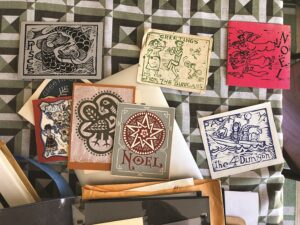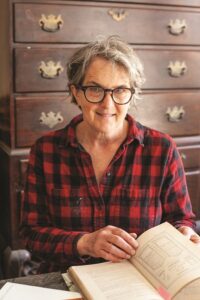
Sculptor Breon Dunigan comes from a long line of local artists. Her great-grandparents were the first in her family to move to the Outer Cape, drawn by Charles Hawthorne’s Cape Cod School of Art. They arrived in Provincetown in the 1920s from Indianapolis, where her great-grandfather Harold Haven Brown was the director of the John Herron Art Institute (now the Herron Institute of Art and Design).
In her Truro home, Dunigan has a copy of his book about applied drawing, its pages browned with age. She carefully opens it to point out its illustrations, which detail concerns like lettering and the correct proportions for furniture.
“I love this book,” said Dunigan. “He writes about acquiring good taste and beauty. It gives me great pleasure to think I came from this lineage. If I’ve inherited anything, it’s wanting to make beautiful things.”
Dunigan wasn’t the only one in her family to inherit a creative gene. Beatrice Bradshaw Brown, Breon’s great-aunt, was a visual artist, composer, and writer. Her grandmother, Barbara Haven (Brown) Malicoat, excelled as a graphic artist, printmaker, and craftsperson. Barbara married Philip Malicoat, a painter, and the couple had two children: Martha and Conrad.
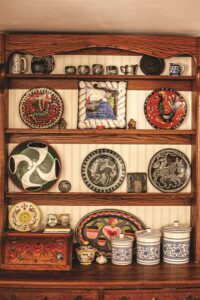
As Mother’s Day approached, Dunigan spoke with the Independent about the influence of her mother, artist Martha Dunigan, and her grandmother — and talked about some of their artwork that fills her home.
“My mother was from Provincetown,” Dunigan said. “She left in 1965. She lived in New York and then North Carolina, but her heart was always here. She was an oddity in North Carolina. Lots of her later work references her childhood in Provincetown and has imagery of boats, houses, and the working pier. A lot of the sculptures are inspired by things she found on the beach. When we were here in the summers, it was completely natural and wonderful.
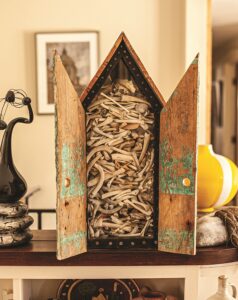
“She went to Oberlin and then studied art in Paris after college. She grew up during the war, when there was an expectation for everyone to pull themselves up by their bootstraps. But when it came down to it, you were subservient to your husband’s needs. She came up during the women’s movement, and she embraced it. But she had to struggle with the notions that she grew up with.
“My parents divorced when I was nine. She had to work a lot. When I was little, she would go away to take classes. She was doing a lot of graphic work — beautiful block prints. She tried to make money with her art, but there was a point when she went back to grad school and started taking herself seriously as an artist.
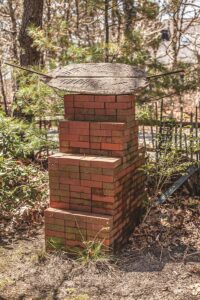
“There was a shift in her identity when she was in her late 30s. She identified as a sculptor and was recognized as a sculptor. She always had a studio in the house where she was working, but when she got serious about sculpture, she moved the studio out of the house.
“She inspired me with the notion that you can be whatever you want to be and do whatever you want to do. ‘Don’t think that because you’re a girl, you can’t do these things,’ was the message. I’ve always felt that way.
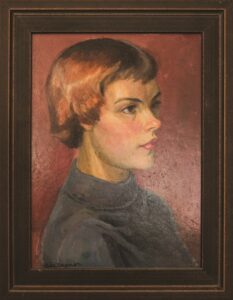
“I was informed by the way my mother did things and the importance she placed on being involved in her studio, but also in the community. She was always involved in arts organizations, supporting other artists coming up, being on the boards of museums. My life has been like that too.
“My grandmother was the best grandmother that ever was. She made us everything. She was an incredible knitter and made us socks, sweaters, and hats from the most complex patterns that she designed herself. We were very lucky. All her design skills went into everything she did. She was always at her desk working on some project.
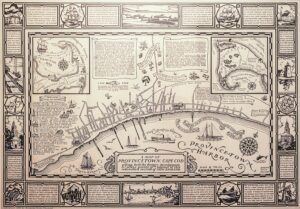
“My grandmother was very much in demand. She did drawings for textbooks, walking maps, and graphics for the town. Many times, she was the one paying the bills, although she was not viewed as the serious artist my grandfather was.
“My mother and grandmother both did block prints. My mother was a printer before being a sculptor. I think the graphic sensibility is from my grandmother’s parents. Every year my grandmother would make elaborate, beautiful Christmas cards from a print and send them out. As an adult, I have done the same thing. There’s a physical part of it, not unlike sculpture. Everyone in the family did block printing. It’s something I have always identified in my direct lineage.
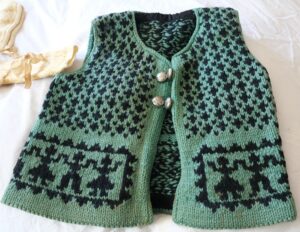
“My grandmother made a lot of practical things. There is an element of domesticity and bringing beauty into every object in your life. Everything in your life is well designed and beautiful. I really agree with that. You want things to reflect an element of beauty. It’s not just art, but how you artfully do things.”
